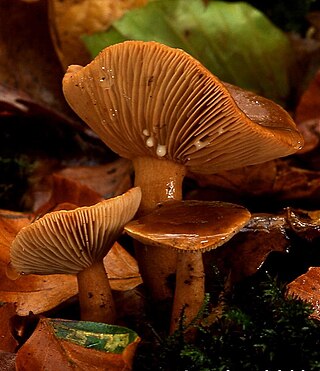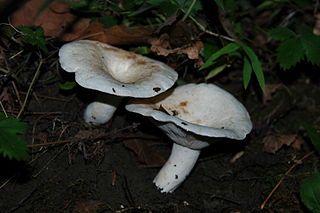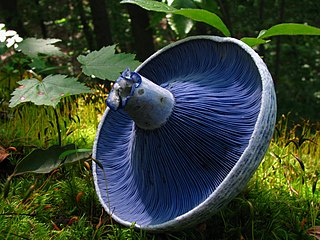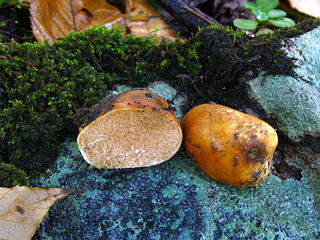
The Russulales are an order of the Agaricomycetes,. According to the Dictionary of the Fungi, the order consists of 12 families, 80 genera, and 1767 species. According to Species Fungorum, the order contains 13 families, 117 genera, and 3,060 species.

The spore print is the powdery deposit obtained by allowing spores of a fungal fruit body to fall onto a surface underneath. It is an important diagnostic character in most handbooks for identifying mushrooms. It shows the colour of the mushroom spores if viewed en masse.

The Russulaceae are a diverse family of fungi in the order Russulales, with roughly 1,900 known species and a worldwide distribution. They comprise the brittlegills and the milk-caps, well-known mushroom-forming fungi that include some edible species. These gilled mushrooms are characterised by the brittle flesh of their fruitbodies.

In mycology, a lamella, or gill, is a papery hymenophore rib under the cap of some mushroom species, most often agarics. The gills are used by the mushrooms as a means of spore dispersal, and are important for species identification. The attachment of the gills to the stem is classified based on the shape of the gills when viewed from the side, while color, crowding and the shape of individual gills can also be important features. Additionally, gills can have distinctive microscopic or macroscopic features. For instance, Lactarius species typically seep latex from their gills.

Lactarius is a genus of mushroom-producing, ectomycorrhizal fungi, containing several edible species. The species of the genus, commonly known as milk-caps, are characterized by the milky fluid ("latex") they exude when cut or damaged. Like the closely related genus Russula, their flesh has a distinctive brittle consistency. It is a large genus with over 500 known species, mainly distributed in the Northern hemisphere. Recently, the genus Lactifluus has been separated from Lactarius based on molecular phylogenetic evidence.

Russula is a very large genus composed of around 750 worldwide species of ectomycorrhizal mushrooms. They are typically common, fairly large, and brightly colored – making them one of the most recognizable genera among mycologists and mushroom collectors. Their distinguishing characteristics include usually brightly coloured caps, a white to dark yellow spore print, brittle, attached gills, an absence of latex, and absence of partial veil or volva tissue on the stem. Microscopically, the genus is characterised by the amyloid ornamented spores and flesh (trama) composed of spherocysts. Members of the related genus Lactarius have similar characteristics but emit a milky latex when their gills are broken. The genus was described by Christian Hendrik Persoon in 1796.

Russula virescens is a basidiomycete mushroom of the genus Russula, and is commonly known as the green-cracking russula, the quilted green russula, or the green brittlegill. It can be recognized by its distinctive pale green cap that measures up to 15 cm (6 in) in diameter, the surface of which is covered with darker green angular patches. It has crowded white gills, and a firm, white stipe that is up to 8 cm (3 in) tall and 4 cm (1.6 in) thick. Considered to be one of the best edible mushrooms of the genus Russula, it is especially popular in Spain and China. With a taste that is described variously as mild, nutty, fruity, or sweet, it is cooked by grilling, frying, sautéeing, or eaten raw. Mushrooms are rich in carbohydrates and proteins, with a low fat content.

The Bondarzewiaceae are a family of fungi in the order Russulales. The type species for both its genus and the family as a whole, Bondarzewia montana, closely resembles members of Polyporales, but has ornamented spores like those of Lactarius or Russula. This characteristic suggested the relationship between physically dissimilar species that eventually led to the restructuring of Russulales using molecular phylogeny. According to the Dictionary of the Fungi, the family contains 8 genera and 48 species.

Milk-cap is a common name that refers to mushroom-forming fungi of the genera Lactarius, Lactifluus, and Multifurca, all in the family Russulaceae. The common and eponymous feature of their fruitbodies is the latex ("milk") they exude when cut or bruised. Mushrooms with typical milk-cap characteristics are said to have a lactarioid habit. Some of them are edible.

Lactifluus piperatus, commonly known as the blancaccio, is a semi-edible basidiomycete fungus of the genus Lactifluus. Despite being edible, it is not recommended by some because of its poor taste, though can be used as seasoning when dried. The fruiting body is a creamy-white mushroom which is funnel-shaped when mature, with exceptionally crowded gills. It bleeds a whitish peppery-tasting milk when cut. Widely distributed across Europe and eastern North America, Lactifluus piperatus has been accidentally introduced to Australia. Mycorrhizal, it forms a symbiotic relationship with various species of deciduous tree, including beech, and hazel, and fruiting bodies are found on the forest floor in deciduous woodland.

Russula delica is a mushroom that goes by the common name of milk-white brittlegill, and is a member of the genus Russula, all of which are collectively known as brittlegills. It is mostly white, with ochraceous or brownish cap markings, and a short robust stem. It is edible, but poor in taste, and grows in coniferous, broadleaved, or mixed woods. It can be confused with other white Russula species and certain white Lactarius species.

Lactifluus volemus, formerly known as Lactarius volemus, and commonly known as the weeping milk cap or bradley, is a species of fungus in the family Russulaceae. It is widely distributed in the northern hemisphere, in temperate regions of Europe, North America and Asia as well as some subtropical and tropical regions of Central America and Asia. A mycorrhizal fungus, its fruit bodies grow on the ground at the base of various species of trees from summer to autumn, either individually or in groups. It is valued as an edible mushroom, and is sold in markets in Asia. Several other Lactifluus mushrooms resemble L. volemus, such as the closely related edible species L. corrugis, but these can be distinguished by differences in distribution, visible morphology, and microscopic characteristics. L. volemus produces a white spore print and has roughly spherical spores about 7–8 micrometres in diameter.

Lactarius indigo, commonly known as the indigo milk cap, indigo milky, the indigo lactarius, or the blue milk mushroom, is a species of agaric fungus in the family Russulaceae. It is a widely distributed species, growing naturally in eastern North America, East Asia, and Central America; it has also been reported in southern France. L. indigo grows on the ground in both deciduous and coniferous forests, where it forms mycorrhizal associations with a broad range of trees. The fruit body color ranges from dark blue in fresh specimens to pale blue-gray in older ones. The milk, or latex, that oozes when the mushroom tissue is cut or broken — a feature common to all members of the genus Lactarius — is also indigo blue, but slowly turns green upon exposure to air. The cap has a diameter of 5–15 cm (2–6 in), and the stem is 2–8 cm (0.8–3 in) tall and 1–2.5 cm (0.4–1.0 in) thick. It is an edible mushroom, and is sold in rural markets in China, Guatemala, and Mexico. In Honduras, the mushroom is called a chora, and is generally eaten with egg; generally as a side dish for a bigger meal.

Multifurca is a rare genus of ectomycorrhizal fungi in the family Russulaceae. It was described in 2008, after molecular phylogenetic study had shown that it forms a monophyletic lineage within the family, sister to Lactarius. The genus contains six species known from the United States, Mexico, Costa Rica, India, China, Thailand, Australia, and New Caledonia, but so far has not been reported from Europe, Africa, or South America. Four of those species were formerly classified as Russula section Ochricompactae, and Multifurca furcata was originally described as a Lactarius species.

Zelleromyces is a genus of fungi in the family Russulaceae. It was first described by mycologists Rolf Singer and Alexander H. Smith in 1960 to contain hypogeous (underground) fungi with gasteroid fruit bodies that "bleed" latex when they are cut.

Lactifluus deceptivus, commonly known as the deceiving milkcap, is a common species of fungus in the family Russulaceae. It is found throughout eastern North America on the ground in coniferous forests near hemlock or deciduous forests near oak, and in oak-dominated forests of Costa Rica. It produces large mushrooms with funnel-shaped caps reaching up to 25 cm (9.8 in) in diameter, on top of hard white stems that may reach 4–10 cm (1.6–3.9 in) long and up to 3 cm (1.2 in) thick. The gills are closely spaced together and yellowish-cream in color. When young, the cap is white in all parts, but the depressed center becomes dull brownish in age and breaks up into scales. The edge of the cap has a roll of cottony tissue that collapses as the cap expands. The surface of the stem—especially near the base—has a velvety texture. The mushroom "bleeds" a milky white acrid latex when it is cut or injured. Similar milk-cap species with which L. deceptivus might be confused include Lactifluus piperatus, L. pseudodeceptivus, L. caeruleitinctus, L. subvellereus, Lactarius arcuatus and Lactarius parvulus.

Lactifluus is one of three genera of mushroom-forming fungi containing species commonly named "milk-caps", the others being Lactarius and Multifurca. It has been separated from Lactarius based on molecular phylogenetic evidence but is very similar to that genus. There are roughly 150 known Lactifluus species, which have a mainly tropical distribution but are also found in the north temperate zone and Australasia. Some of them are edible mushrooms.
Multifurca zonaria is a species of mushroom-forming fungus in the genus Russulaceae. Originally described from Thailand as a Russula species in 2003, it was moved to the newly created genus Multifurca in 2008.

Lactifluus clarkeae, formerly known as Lactarius clarkeae, is a species of mushroom-forming fungus in the family Russulaceae. It is found in Australia and New Zealand in mycorrhizal association with species of Nothofagus and the family Myrtaceae.

















